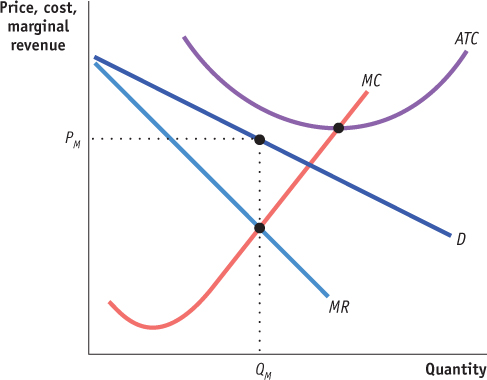Tackle the Test: Free-Response Questions
Question
Draw a correctly labeled graph showing a monopoly incurring a loss in the short run. Assume that the marginal cost curve is swoosh-
shaped. How can the monopolist determine whether to shut down or produce at a loss in the short run?
Rubric for FRQ 1 (9 points)

1 point: Axes are correctly labeled.
1 point: The demand curve is labeled and negatively sloped.
1 point: The marginal revenue curve is labeled, negatively sloped, and below the demand curve.
1 point: The profit-
maximizing quantity is labeled on the horizontal axis where MC = MR. 1 point: Price is determined on the demand curve above the point where MC = MR.
1 point: The average total cost curve is labeled and U-
shaped. 1 point: Average total cost is above price at the profit-
maximizing output. 1 point: The marginal cost curve crosses the average total cost curve at the lowest point on the average total cost curve.
1 point: The firm will produce despite a loss in the short run if P ≥ AVC.
Question
Draw a graph showing a monopoly earning a normal profit in the short run. Assume that the marginal cost curve is swoosh-
shaped. Can a monopoly earn a positive profit in the long run? Explain. (9 points)
Rubric for FRQ 2 (9 points)

1 point: Axes are correctly labeled as “$ per unit” or “Price, cost, marginal revenue” and “Quantity.”
1 point: The demand curve is labeled and downward-sloping.
1 point: The marginal revenue curve is labeled, downward-sloping, and below the demand curve.
1 point: The profit-maximizing quantity is labeled on the horizontal axis where MC = MR.
1 point: Price is determined on the demand curve above the point where MC = MR.
1 point: The average total cost curve is labeled and U–shaped.
1 point: Average total cost equals price at the profit-maximizing output.
1 point: The marginal cost curve crosses the average total cost curve at the lowest point on the average total cost curve.
1 point: Yes, a monopoly can earn a positive profit in the long run with the help of barriers to entry that keep out competitors.